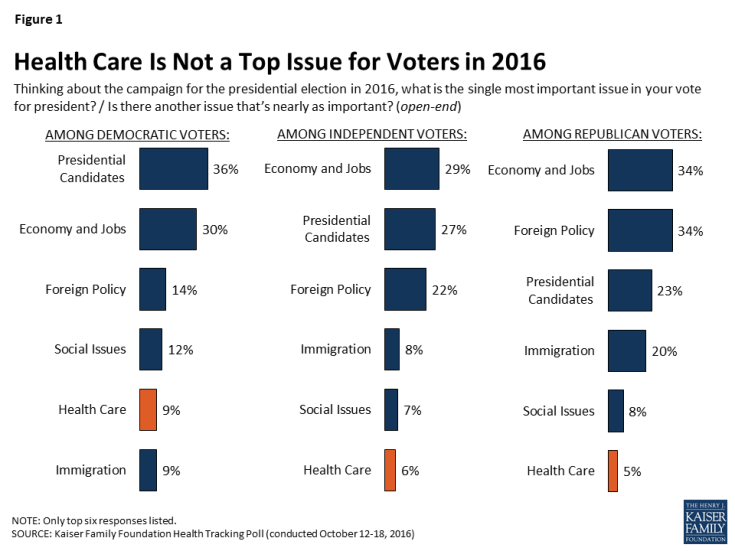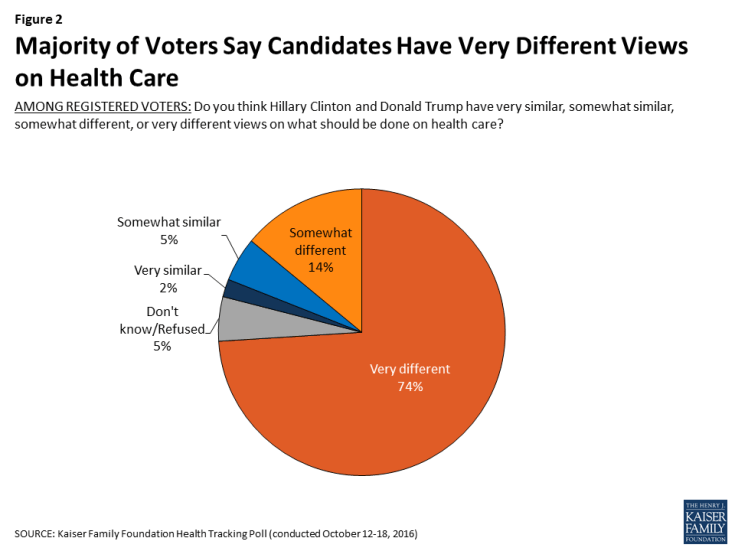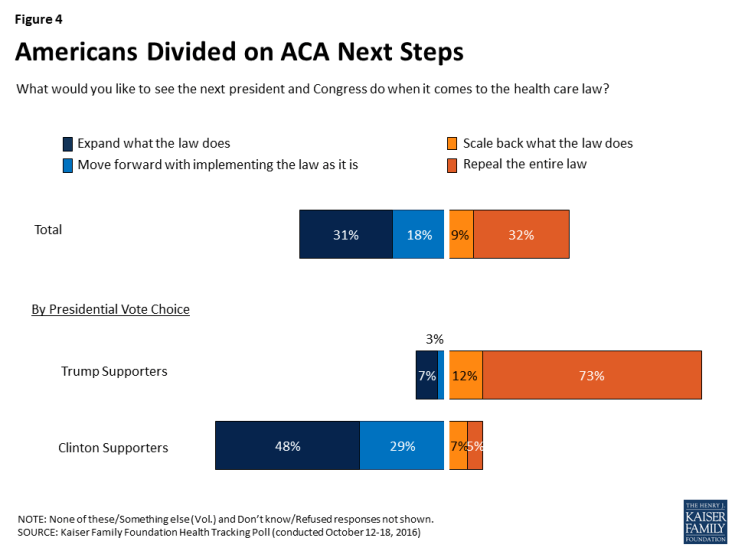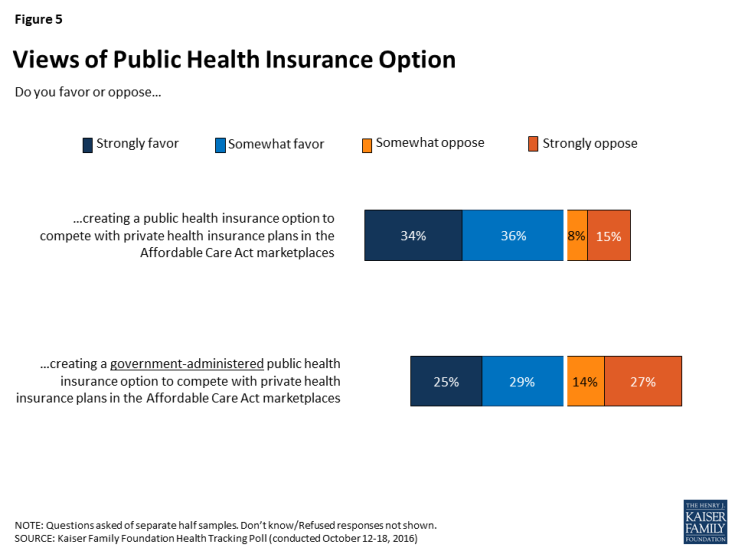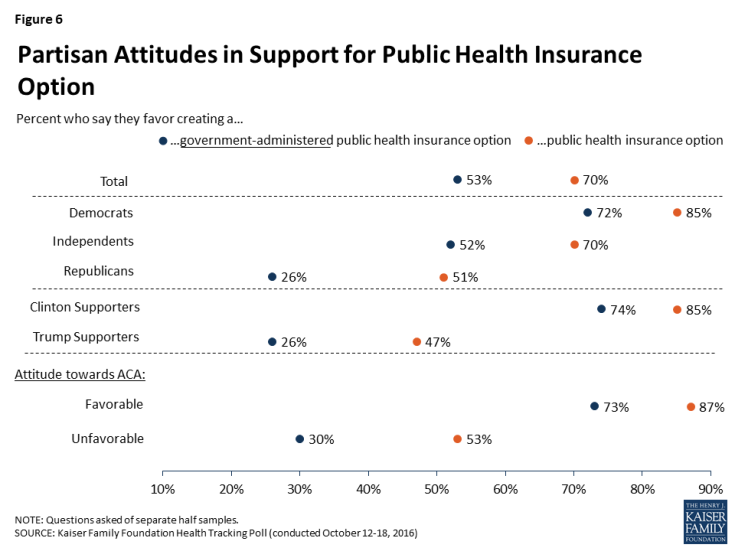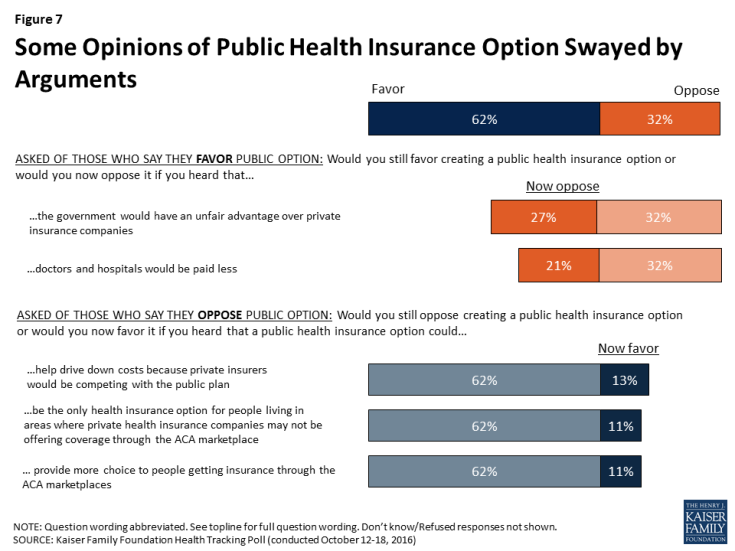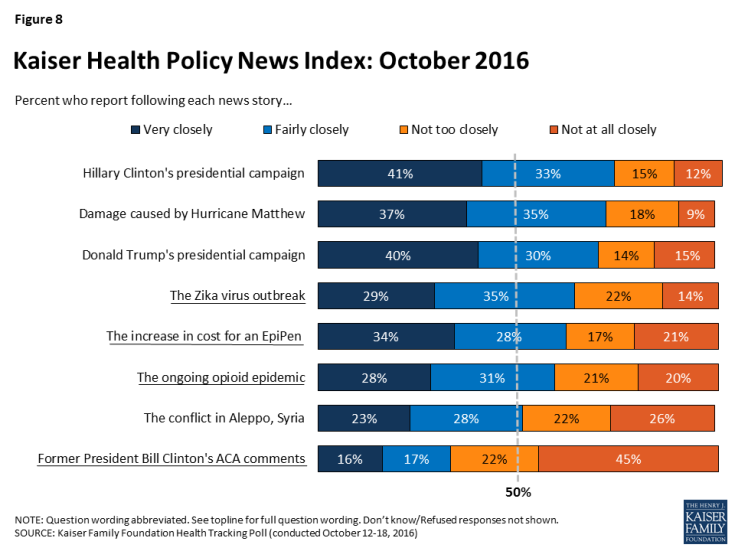Kaiser Health Tracking Poll: October 2016
KEY FINDINGS:
- As the presidential election continues to dominate the attention of most Americans, the candidates themselves, the economy and jobs, and foreign policy rank as top factors in voters’ decisions, with health care following far below. However, the vast majority of voters say there are differences between the two presidential candidates’ views on health care, although more feel they have a good understanding of what Democratic presidential nominee Hillary Clinton is proposing in the health care arena than Republican presidential nominee Donald Trump.
- When thinking about health care priorities for the next president and Congress to address, dealing with the high price of prescription drugs tops the public’s list while issues specific to the Affordable Care Act (ACA), such as repealing provisions of the law or repealing the law entirely, are viewed as top priorities by fewer Americans.
- The public remains divided on what’s next for the ACA with about equal shares saying the law should be repealed as saying it should be expanded. As discussions about the challenges facing the ACA marketplaces continue, about two-thirds of Americans say they favor creating a public health insurance option to compete with private health insurance plans in the ACA marketplaces, but support for this is relatively malleable, with attitudes shifting after hearing counterarguments.
- With the ACA’s fourth open enrollment period beginning on November 1st, the corresponding Data Note examines the public’s view on the future of the 2010 health care law, which groups they think are better off as a result of this legislation, and what sources they go to for information about the law.
The 2016 Presidential Election
With less than two weeks until Election Day, the October Kaiser Health Tracking Poll finds that when asked in their own words the single most important issue in their vote for president, voters offer the candidates themselves, the economy and jobs, and foreign policy rank as top factors in their decisions. On the other hand, a much smaller number of voters – regardless of party – volunteer health care as the most important issue. The poll finds that about one-third of Democratic voters (36 percent) say the candidates themselves are the most important issue in their vote. For Republican voters, the economy and jobs (34 percent) and foreign policy (34 percent) are volunteered most often. Similar shares of independent voters mention the presidential candidates (27 percent) and the economy and jobs (29 percent).
While health care is playing a limited role in voters’ decisions, the majority of voters say the two presidential candidates have different views on what should be done on health care. Nearly nine in ten voters say the candidates’ views on what should be done on health care are either “very different” (74 percent) or “somewhat different” (14 percent), with fewer than one in ten saying they are either “very” or “somewhat” similar (2 percent and 5 percent, respectively).
Although discussion of health care policies on the campaign trail has been somewhat limited, seven in ten (71 percent) voters say they understand (either “very well” or “somewhat well”) what Hillary Clinton is proposing to do on health care if she wins the election while fewer (51 percent of voters) say the same of Donald Trump.
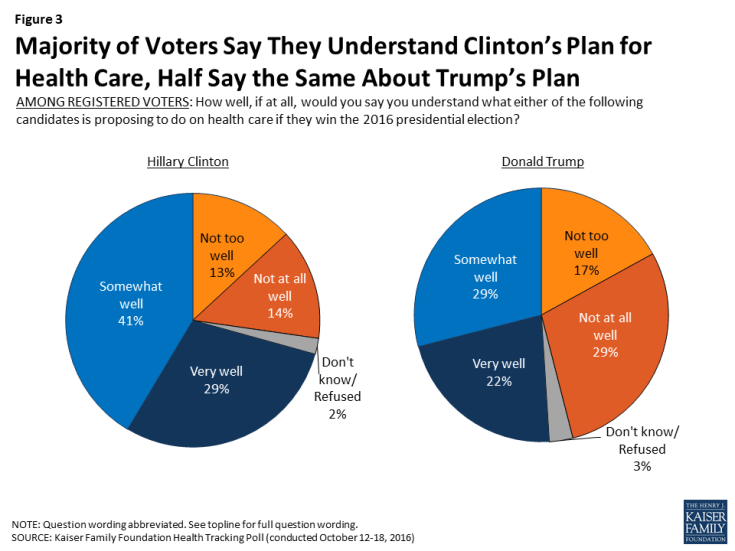
Figure 3: Majority of Voters Say They Understand Clinton’s Plan for Health Care, Half Say the Same About Trump’s Plan
Health Care Priorities for the Next President and Congress
This month’s Kaiser Health Tracking Poll also examines the public’s attitudes on which health care issues should be a priority for the next president and Congress. Making sure high-cost drugs for chronic conditions, such as HIV, hepatitis, mental illness and cancer, are affordable to those who need them is viewed as a “top priority” by 74 percent of the public and majorities of individuals across party lines. In addition, the majority of the public say government action to lower prescription drug prices is a top priority (however, larger shares of Democrats and independents than Republicans view this as a top priority). Issues specific to the ACA, such as repealing provisions of the law or repealing the law entirely, are viewed as top priorities by fewer Americans. However, repealing the ACA is seen as a top priority by six in ten Republicans – ranking second in top priorities among this group.
| Table 1: Top Health Care Priorities for the Next President and Congress | ||||
| Percent who say each of the following should be a top health care priority for the next President and Congress | Total | Democrats | Independents | Republicans |
| Making sure that high-cost drugs for chronic conditions, such as HIV, hepatitis, mental illness and cancer, are affordable to those who need them | 74% | 84% | 73% | 68% |
| Government action to lower prescription drug prices | 63 | 75 | 64 | 49 |
| Making sure health plans have sufficient provider networks of doctors and hospitals | 57 | 62 | 54 | 53 |
| Protecting people from being charged high prices when they visit hospitals or outpatient clinics covered by their health plan but are seen by a doctor not covered by their plan | 54 | 60 | 56 | 43 |
| Making information comparing the quality of health care provided by doctors and hospitals more available to patients | 53 | 59 | 54 | 42 |
| Making information about the price of doctors’ visits, tests, and procedures such as hip replacements and MRIs more available to patients | 50 | 52 | 51 | 45 |
| Making information about what doctors and hospitals are covered under different health insurance plans more available | 49 | 53 | 46 | 50 |
| Helping people with moderate incomes pay high out-of-pocket costs for medical care | 44 | 51 | 42 | 39 |
| Repealing the requirement that nearly all Americans have health insurance or else pay a fine | 38 | 27 | 39 | 51 |
| Repealing the entire health care law | 37 | 17 | 40 | 60 |
| Repealing the requirement that employers with 50 or more workers pay a fine if they don’t offer health insurance | 29 | 29 | 29 | 28 |
| Reducing the amount of financial assistance available to help people buy health insurance in order to save the government money | 25 | 24 | 27 | 18 |
| Eliminating a tax on higher cost employer-sponsored health plans, also called Cadillac plans, that helps pay for the health care law | 24 | 27 | 22 | 22 |
| NOTE: Items asked of half samples. | ||||
Next Steps for the Health Care Law
When it comes to the future of the Affordable Care Act, the public is divided on what they want to see the next president and Congress do. About one-third (32 percent) of the public want to see the next president and Congress repeal the entire law which is similar to the share (31 percent) who want to see the next administration expand what the health care law does. One in five (18 percent) say they want to see the next president and Congress move forward with implementing the law as it is while 9 percent want to see the next administration scale back what the law does.
Voters who currently support Democratic presidential candidate Hillary Clinton are also more likely to say they want to see the next president and Congress expand the law (48 percent) or move forward with implementing the law as it is (29 percent) than voters who currently support Republican presidential candidate Donald Trump (7 percent and 3 percent, respectively). Three-fourths (73 percent) of Trump supporters say they want to see the next president and Congress repeal the entire law. These differences mirror overall partisan differences with larger shares of Democrats (48 percent) wanting to see the law expanded than independents (31 percent) and Republicans (9 percent).
Public Health Insurance Option
Decisions by insurers to no longer sell coverage through some ACA marketplaces have spurred renewed discussions of establishing a public health insurance option in an effort to address potential gaps in access to health insurance plans through the marketplace. Overall, about two-thirds (62 percent) of Americans favor a public health insurance option to compete with private health insurance plans in the ACA marketplaces; however, how the proposal is described and labeled affects the level of support.
When half of the sample are asked whether they favor or oppose creating a public health insurance option, 70 percent express a favorable view while one-fourth (24 percent) oppose. When the other half of the sample are asked whether they favor or oppose creating a government-administered public health insurance option, about half (53 percent) say they favor such a plan while 41 percent oppose.
Across all partisan groups, the inclusion of the detail of “government-administered” in the question wording decreases favorability – yet, to varying degrees. Majorities of Democrats, Clinton supporters, and individuals with a favorable view of the ACA say they favor both a government-administered public health insurance option and a public health insurance option. Among independents, a majority (70 percent) favor a public health insurance option but fewer (52 percent) favor creating a government-administered public health insurance option. Smaller shares of Republicans, Trump supporters, and individuals who have an unfavorable view of the ACA favor either proposal. However, the share who favor a government-administered public health insurance option is significantly smaller than those who favor a public health insurance option.
How Flexible Are Americans’ Opinions of a Public Option?
Until recently, there had been little public discussion or details of a public health insurance plan. Therefore, it is unsurprising that for some, attitudes on this issue can be swayed when they hear messages being made from the alternative viewpoint. For instance, 21 percent overall shift their opinion from favor to oppose after hearing the argument often made by opponents of the proposal that doctors and hospitals would be paid less under a public health insurance plan, and one-fourth (27 percent) of the public shifts their opinion to oppose when hearing that the government would have an unfair advantage over private insurance companies. On the other side of the debate, some of those who originally say they oppose a public health insurance option are also persuaded by hearing arguments often made by supporters of the proposal. About one in ten change their stance from oppose to favor after hearing that the public health insurance option could help drive down costs because private insurers would be competing with the public plan (13 percent), provide more choice to people getting insurance through the ACA marketplaces (11 percent), or be the only health insurance option for people living in areas where private health insurance companies may not be offering coverage through the ACA marketplaces (11 percent).
Kaiser Health Policy News Index: October 2016
The October Kaiser Health Tracking Poll finds the 2016 presidential campaign and Hurricane Matthew dominating the public’s attention during the past month. Nearly three-fourths of Americans say they were closely following news stories about Hillary Clinton’s presidential campaign (73 percent), the damage caused by Hurricane Matthew in the Atlantic Ocean (72 percent), and Donald Trump’s presidential campaign (70 percent). Fewer Americans report closely following the top health stories during the month, with two-thirds closely following news about the Zika virus outbreak, 61 percent following news about the increase in cost for an EpiPen, and 59 percent following news about the ongoing opioid epidemic. Smaller shares report closely following news about the conflict in Aleppo, Syria (51 percent) or former President Bill Clinton’s remarks about the Affordable Care Act (33 percent).

